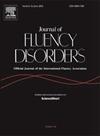口吃自我耻辱量表的波兰改编:量表开发与分析
IF 2.1
3区 医学
Q1 AUDIOLOGY & SPEECH-LANGUAGE PATHOLOGY
引用次数: 0
摘要
目的目前还没有针对波兰语口吃者的自我污名化评估,而之前的研究已经明确了在治疗环境中实施这种措施的必要性。本研究的目的是调整口吃自我耻辱量表(4S)以适应波兰语。方法本研究招募了108名波兰口吃成年人(女性48.1% %,男性51.9% %),年龄从18岁到67岁不等。参与者主要通过言语语言病理学家(slp)和自助小组组长招募。参与者完成了4S量表的波兰语翻译,以及关于一般心理健康福利和生活满意度的问题,他们自己的语言评估,与口吃相关的困难的感知,以及感知到的支持水平。结果波兰学生的污名意识得分最高。总体量表与个体子量表之间存在显著的相关关系,量表具有良好的内部一致性。平均得分与Boyle(2015)量表评价结果基本一致。内部一致性水平与Boyle(2015)和其他翻译相当。结果表明,很大一部分参与者意识到与口吃相关的耻辱(67.59 %的参与者在耻辱意识得分上得分高于理论中点),相当一部分参与者对自己个人持高度消极的耻辱态度(38.89 %的参与者在耻辱应用得分上得分高于理论中点)。研究结果与先前的评估和调整一致,表明4S可以可靠地用于波兰语境。由于波兰的言语和语言治疗领域越来越关注口吃者的内在感受和情绪,而不仅仅是专注于身体言语障碍的治疗,对自我耻辱的评估是言语语言病理学家工具包的重要补充。本文章由计算机程序翻译,如有差异,请以英文原文为准。
Polish adaptation of the Self-Stigma of Stuttering Scale: Scale development and analysis
Purpose
There is currently no available assessment of self-stigmatization for people who stutter in Polish, and previous research has identified a clear need for such a measure to be implemented in therapy settings. The aim of this study was to adapt the Self-Stigma of Stuttering Scale (4S) to Polish.
Method
The study recruited 108 Polish adults who stutter (48.1 % female, 51.9 % male), ranging in age from 18 to 67. Participants were mainly recruited via speech language pathologists (SLPs) and self-help group leaders. Participants completed the Polish translation of the 4S scale, as well as questions on general mental health welfare and life satisfaction, their own speech assessment, perceptions of difficulties associated with stuttering, and perceived level of support.
Results
The highest score of the Polish 4S was for stigma awareness. The overall scale and individual subscales were significantly correlated with each other and the scale showed good internal consistency. Mean scores were generally in line with Boyle’s (2015) scale evaluation results. Levels of internal consistency were comparable to those in Boyle (2015) and to other translations. The results show that a large proportion of participants were aware of the stigma associated with stuttering (reflected in 67.59 % of participants scoring above the theoretical midpoint on the Stigma Awareness Score) and a substantial proportion of participants applied highly negative stigmatizing attitudes to themselves personally (38.89 % of participants scored above the theoretical midpoint on the Stigma Application Score).
Conclusions
The study findings align with previous assessments and adaptations, suggesting the 4S can reliably be used in the Polish context. As the field of speech and language therapy in Poland is increasingly more concerned with the internal feelings and emotions of people who stutter rather than solely focusing on treatment of physical speech disruption, an assessment of self-stigma is an important addition to the speech-language pathologists’ toolkit.
求助全文
通过发布文献求助,成功后即可免费获取论文全文。
去求助
来源期刊

Journal of Fluency Disorders
AUDIOLOGY & SPEECH-LANGUAGE PATHOLOGY-REHABILITATION
CiteScore
3.70
自引率
14.30%
发文量
23
审稿时长
>12 weeks
期刊介绍:
Journal of Fluency Disorders provides comprehensive coverage of clinical, experimental, and theoretical aspects of stuttering, including the latest remediation techniques. As the official journal of the International Fluency Association, the journal features full-length research and clinical reports; methodological, theoretical and philosophical articles; reviews; short communications and much more – all readily accessible and tailored to the needs of the professional.
 求助内容:
求助内容: 应助结果提醒方式:
应助结果提醒方式:


